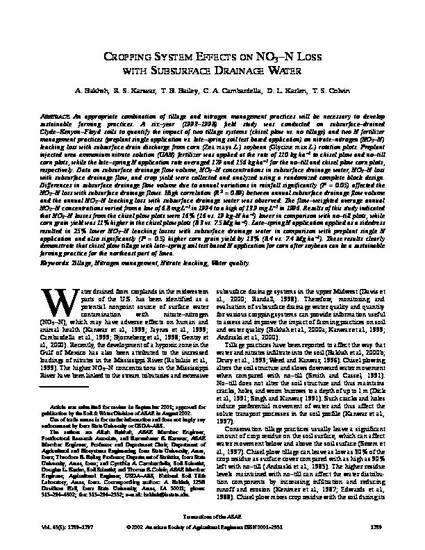
An appropriate combination of tillage and nitrogen management practices will be necessary to develop sustainable farming practices. A six–year (1993–1998) field study was conducted on subsurface–drained Clyde–Kenyon–Floyd soils to quantify the impact of two tillage systems (chisel plow vs. no tillage) and two N fertilizer management practices (preplant single application vs. late–spring soil test based application) on nitrate–nitrogen (NO3–N) leaching loss with subsurface drain discharge from corn (Zea mays L.) soybean (Glycine max L.) rotation plots. Preplant injected urea ammonium nitrate solution (UAN) fertilizer was applied at the rate of 110 kg ha–1 to chisel plow and no–till corn plots, while the late–spring N application rate averaged 179 and 156 kg ha–1 for the no–till and chisel plow corn plots, respectively. Data on subsurface drainage flow volume, NO3–N concentrations in subsurface drainage water, NO3–N loss with subsurface drainage flow, and crop yield were collected and analyzed using a randomized complete block design. Differences in subsurface drainage flow volume due to annual variations in rainfall significantly (P = 0.05) affected the NO3–N loss with subsurface drainage flows. High correlation (R2 = 0.89) between annual subsurface drainage flow volume and the annual NO3–N leaching loss with subsurface drainage water was observed. The flow–weighted average annual NO3–N concentrations varied from a low of 6.8 mg L–1 in 1994 to a high of 13.9 mg L–1 in 1996. Results of this study indicated that NO3–N losses from the chisel plow plots were 16% (16 vs. 19 kg–N ha–1) lower in comparison with no–till plots, while corn grain yield was 11% higher in the chisel plow plots (8.3 vs. 7.5 Mg ha–1). Late–spring N application applied as a sidedress resulted in 25% lower NO3–N leaching losses with subsurface drainage water in comparison with preplant single N application and also significantly (P = 0.5) higher corn grain yield by 13% (8.4 vs. 7.4 Mg ha–1). These results clearly demonstrate that chisel plow tillage with late–spring soil test based N application for corn after soybean can be a sustainable farming practice for the northeast part of Iowa.
Available at: http://works.bepress.com/douglas_karlen/9/

This article is from Transactions of the ASAE 45 (2002): 1789–1797, doi:10.13031/2013.11430